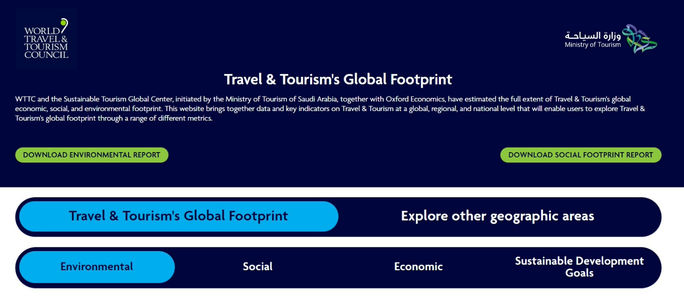
by Lacey Pfalz
Last updated: 10:40 AM ET, Thu February 22, 2024
The World Travel & Tourism Council launched a new website focusing solely on providing global, regional and country-by-country data surrounding the travel and tourism industry��s sustainability, a great resource as destinations and travel companies worldwide seek to lessen their negative impact on the environment and local communities.?
The environmental and social research spans 185 countries and focuses upon both direct and indirect sources of carbon emissions, water usage and other key metrics. The data was collected from 2010 to 2019, 2020 and 2021 and provides important information detailing how sustainable the industry is, and where it can improve.?
Travelers and members of the industry can view the research at GlobalTravelFootprint.wttc.org. The entire project was a collaboration between WTTC and Oxford Economics, Accenture and the Ministry of Tourism of Saudi Arabia.

An overview of the Global Travel Footprint website, which measures the global, regional and country-specific travel industry in several different ways. (Photo Credit: WTTC)
��We knew that for us, to spur economic growth, we had to tackle climate change and work to preserve our oceans and our forests, which are the top natural resources of Puerto Rico. But it had to go beyond us: it had to do more,�� said Alexandra Ruiz, Chief Marketing Officer for the Puerto Rico Tourism Company, which is the equivalent of the tourism ministry for the island, during a webinar on the new website.
��Sustainability goes beyond greening our products and making operations more environmentally friendly���� Ruiz continued. ��For us to be truly sustainable, we have to consider social sustainability as well. That��s when WTTC came in and we created the first report����
With WTTC��s data, the island was able to measure and note the industry��s largest emissions producers �� aviation and cruise ships �� and discover how many women and youth are employed in the industry, which has spurred the island��s travel industry to make more informed decisions about both sustainability and socially minded initiatives and programs.?
Sustainability Metrics in the Travel Industry
In the 2010s, the global industry grew 4.5 percent, whereas carbon emissions produced by the industry only grew 2.5 percent, showcasing that the industry is growing faster than the rate of emissions produced, which is a good sign overall.?
The travel and tourism industry produced 8.1 percent of all emissions produced in 2019, with that largely focusing upon transportation and utilities �� reiterating how crucial it is to focus on greener fuels and transport options, along with generating renewable energy.?
Besides carbon emissions, the new website also showcases the industry��s impact on water usage, energy usage, oil usage, material extraction and its contribution to airborne pollutants.?
The Social Analysis of The Travel Industry
The new website also compiles and showcases data surrounding the travel industry��s social impact, especially when it comes to employment. Users will learn that more youth are employed in the industry than the global average, and that India and South Korea are the leading countries showcasing youth employment in the industry.?
They��ll also learn that 40 percent of all people employed in the industry are women, and they make up a larger share of the travel and tourism workforce in regions like the Americas and Asia-Pacific than in the overall workforce.?
The Bottom Line
Why is this data, readily available and transparent for all to see, so important? Measuring the data is the first step towards realizing how far we need to go to lessen the industry��s negative impact on people and the planet, and foster more specific sustainability by destination: for example, making destinations that have less access to fresh water more aware of what they can do to lessen water usage when possible.??
For the latest travel news, updates and deals, subscribe to the daily TravelPulse newsletter.
Topics From This Article to Explore